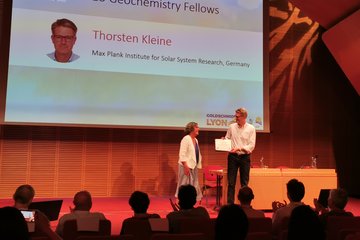Alle Typen
261.
Zeitschriftenartikel
Field-aligned particle streaming in the duskside high latitude Jovian magnetosphere. Advances in Space Research 20, S. (2)225 - (2)228 (1997)
262.
Zeitschriftenartikel
Energetic electron beams in the duskside Jovian magnetosphere: Ulysses EPAC and HI-SCALE measurements. Planetary and Space Science 45, S. 1473 - 1480 (1997)
263.
Zeitschriftenartikel
ULYSSES observations of energetic H3+ ions in Jupiter's magnetosphere. Advances in Space Research 20, S. (2)229 - (2)232 (1997)
264.
Zeitschriftenartikel
Plasma wave characteristics of the Jovian magnetopause boundary layer: Relationship to the Jovian aurora? Journal Geophysical Research 102, S. 4751 - 4764 (1997)
265.
Zeitschriftenartikel
Galileo Energetic Particle Detector (EPD) anisotropies during plasma sheet crossings at Jupiter. Bulletin of the American Astronomical Society 29, S. 3 (1997)
266.
Zeitschriftenartikel
The charge state of helium in the Jovian magnetosphere: a possible method to determine it. Planetary and Space Science 44, S. 71 - 75 (1996)
267.
Zeitschriftenartikel
Low-energy particle oscillations and correlations with hydromagnetic waves in the Jovian magnetosphere: Ulysses measurements. Journal Geophysical Research 101, S. 17305 - 17312 (1996)
268.
Zeitschriftenartikel
On the minimum fluxes of low-energy ions (0.5 MeV/nuc-8 MeV/nuc) at high heliospheric latitudes. Advances in Space Research 15, S. (7)81 - (7)84 (1995)
269.
Zeitschriftenartikel
The elemental composition in energetic particle events at high heliospheric latitudes. Space Science Reviews 72, S. 339 - 342 (1995)
270.
Zeitschriftenartikel
Energetic particle observations at high heliographic latitudes. Space Science Reviews 72, S. 285 - 289 (1995)
271.
Zeitschriftenartikel
Energetic particle observations in high heliographic latitudes. Nuclear Physics B (Proc. Suppl.) 39A, S. 87 - 93 (1995)
272.
Zeitschriftenartikel
Ion measurements in the Jovian magnetosphere by the Ulysses EPAC experiment: A comparison between dawn and dusk sectors. Advances in Space Research 16, S. (4)183 - (4)186 (1995)
273.
Zeitschriftenartikel
A particle event at 5 AU and 20o southern latitude from measurements with the EPAC instrument on Ulysses. Space Science Reviews 72, S. 343 - 346 (1995)
274.
Zeitschriftenartikel
Three-dimensional particle anisotropies in and near the plasma sheet of Jupiter observed by the EPAC experiment on board the Ulysses spacecraft. Planetary and Space Science 41, S. 953 - 966 (1993)
275.
Zeitschriftenartikel
An overview of energetic particle measurements in the Jovian magnetosphere with the EPAC sensor on Ulysses. Science 257, S. 1553 - 1557 (1992)
276.
Zeitschriftenartikel
Energetic particle composition variations during the March 1991 events measured with the Ulysses EPAC instrument. Geophysical Research Letters 19, S. 1255 - 1258 (1992)
277.
Zeitschriftenartikel
Diffusive shock acceleration and the March 1991 solar events. Geophysical Research Letters 19, S. 1259 - 1262 (1992)
278.
Buch
Saturn in the 21st Century. Cambridge University Press, Cambridge (2018), 496 S.
279.
Buchkapitel
Global Configuration and Seasonal Variations of Saturn’s Magnetosphere. In: Saturn in the 21st Century, S. 126 - 165 (Hg. Baines, K. H.; Flasar, F. M.; Krupp, N.; Stallard, T.). Cambridge UP, Cambridge UK (2018)
280.
Buchkapitel
Local Time Asymmetries in Saturn's Magnetosphere. In: Dawn-Dusk Asymmetries in Planetary Plasma Environments, S. 323 - 336 (Hg. Haaland, S.; Runov, A.; Forsyth, C.). Wiley, Hoboken (2017)











